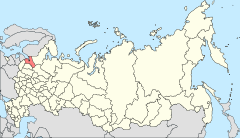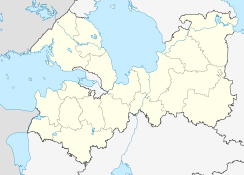- Staraya Ladoga
-
For other uses, see Ladoga (disambiguation).
Staraya Ladoga (English)
Старая Ладога (Russian)- Inhabited locality - 
Location of Leningrad Oblast in RussiaCoordinates: 59°59′N 32°18′E / 59.983°N 32.3°ECoordinates: 59°59′N 32°18′E / 59.983°N 32.3°E Administrative status Country Russia Federal subject Leningrad Oblast Statistics Population (2002 Census) 3,200 inhabitants[1] Time zone MSD (UTC+04:00)[2] Founded 753[citation needed] Postal code(s) 187412[citation needed] Staraya Ladoga (Russian: Ста́рая Ла́дога), Finnish: Vanha Laatokka or the Aldeigjuborg of Norse sagas, is a village (selo) in the Volkhovsky District of Leningrad Oblast, Russia, located on the Volkhov River near Lake Ladoga, 8 km north of the town of Volkhov. The village used to be a prosperous trading outpost in the 8th and 9th centuries. A multi-ethnic settlement, it was dominated by Scandinavians who were called by the name of Rus and for that reason is sometimes called the first capital of Russia.
Contents
Origin and name
Dendrochronology suggests that Ladoga was founded in 753. Until 950, it was one of the most important trading ports of Eastern Europe. Merchant vessels sailed from the Baltic Sea through Ladoga to Novgorod and then to Constantinople or the Caspian Sea. This route is known as the Trade Route from the Varangians to the Greeks. An alternative way led down the Volga River along the Volga trade route to the Khazar capital of Atil, and then to the southern shores of the Caspian Sea, all the way to Baghdad. Tellingly, the oldest Arabian Middle Age coin in Europe was unearthed in Ladoga.
Old Ladoga's inhabitants were Norsemen, Finns, and Slavs, hence different names for the city. The original Finnish name, Alode-joki (i.e., "lowland river"), was rendered as "Aldeigja" in Norse language and as "Ladoga" (Ладога) in Old East Slavic.
Ladoga under Rurik and Rurikids
 Eighth to Tenth Century Viking burial mounds along the Volkhov River near Staraya Ladoga.
Eighth to Tenth Century Viking burial mounds along the Volkhov River near Staraya Ladoga.
According to the Hypatian Codex, the legendary Varangian leader Rurik arrived at Ladoga in 862 and made it his capital. Rurik's successors later moved to Novgorod and then to Kiev, thus laying foundations for the powerful state of Kievan Rus. There are several huge kurgans, or royal funerary barrows, at the outskirts of Ladoga. One of them is said to be Rurik's grave, and another one—that of his successor Oleg. The Heimskringla and other Norse sources mention that in the late 990s Eiríkr Hákonarson of Norway raided the coast and set the town ablaze. Ladoga was the most important trading center in Eastern Europe from about 800 to 900 CE, and it is estimated that between 90 to 95% of all Arab dirhams found in Sweden passed through Ladoga.
Ladoga's next mention in chronicles is dated to 1019, when Ingigerd of Sweden married Yaroslav of Novgorod. Under the terms of their marriage settlement, Yaroslav ceded Ladoga to his wife, who appointed her father's cousin, the Swedish earl Ragnvald Ulfsson, to rule the town. This information is confirmed by sagas and archaeological evidence, which suggests that Ladoga gradually evolved into a primarily Varangian settlement. At least two Swedish kings spent their youths in Ladoga, king Stenkil and Inge I, and possibly also king Anund Gårdske.
In the 12th and 13th centuries, Ladoga functioned as a trade outpost of the powerful Novgorod Republic. Later its trade significance declined and most of the population engaged in fishing in 15th century.[3] After new fortresses such as Oreshek and Korela were constructed in 14th century further to the west of Ladoga the town's military significance also decreased. Ladoga belonged to the Vodskaya pyatina of the republic and contained 84 homesteads in 15th century; most of the land belonged to the church.[3] The Novgorodians built there a citadel with five towers and several churches. The fortress was rebuilt at the turn of the 15th and 16th centuries, while the mid-12th-century churches of St. George and of Mary's Assumption stand in all their original glory. Inside St. George's, some magnificent 12th-century frescoes are still visible.
The reconstruction of part Staraya Ladoga's fortress is expected to be completed in 2010.[4]
Sights and landmarks
In 1703, Peter the Great founded the town of Novaya Ladoga (New Ladoga) closer to the bank of Lake Ladoga. The ancient fortress thenceforth declined and came to be known as Old Ladoga, in order to distinguish it from the new town.
The heart of Staraya Ladoga is an old fortress where the Yelena River flows into the Volkhov River. In earlier times, it was a strategic site because it was the only possible harbour for sea-vessels that could not navigate through the Volkhov River.
Apart from the churches mentioned above, there is a mid-12th century church of St. Climent, which stands in ruins. There is also a monastery, dedicated to St. Nicholas and constructed mainly in the 17th century.
References
- ^ Федеральная служба государственной статистики (Federal State Statistics Service) (2004-05-21). "Численность населения России, субъектов Российской Федерации в составе федеральных округов, районов, городских поселений, сельских населённых пунктов – районных центров и сельских населённых пунктов с населением 3 тысячи и более человек (Population of Russia, its federal districts, federal subjects, districts, urban localities, rural localities—administrative centers, and rural localities with population of over 3,000)" (in Russian). Всероссийская перепись населения 2002 года (All-Russia Population Census of 2002). Federal State Statistics Service. http://www.perepis2002.ru/ct/doc/1_TOM_01_04.xls. Retrieved 2010-03-23.
- ^ Правительство Российской Федерации. Постановление №725 от 31 августа 2011 г. «О составе территорий, образующих каждую часовую зону, и порядке исчисления времени в часовых зонах, а также о признании утратившими силу отдельных Постановлений Правительства Российской Федерации». Вступил в силу по истечении 7 дней после дня официального опубликования. Опубликован: "Российская Газета", №197, 6 сентября 2011 г. (Government of the Russian Federation. Resolution #725 of August 31, 2011 On the Composition of the Territories Included into Each Time Zone and on the Procedures of Timekeeping in the Time Zones, as Well as on Abrogation of Several Resolutions of the Government of the Russian Federation. Effective as of after 7 days following the day of the official publication).
- ^ a b Bernadsky, Viktor Nikolayevich (1961). Новгород и новгородская земля в XV веке (Novgorod and the Novgorod Land in XV century). Leningrad (Saint Petersburg): published by the USSR Academy of Sciences. pp. 130–131.
- ^ "In Staraya Ladoga in 2010 will recreate Strelochnaya tower of a fortress Russian: В Старой Ладоге в 2010 году воссоздадут Стрелочную башню крепости" (in ru). Leningrad Oblast (karpovka.net). 2009-08-22. http://karpovka.net/2009/08/22/9440/. Retrieved 2009-08-24.
External links
Garðaríki Names in italics are settlements whose Norse names are not recordedVolkhov-Volga trade route 
Dvina-Dnieper trade route Other locations Major fortresses of Western Russia 
Trade emporia of the Viking Age (Baltic Sea)  Categories:
Categories:- Viking Age populated places
- 753 establishments
- Rural localities in Leningrad Oblast
- Novgorod Republic
- Trading posts of the Hanseatic League
- Archaeological sites in Russia
- Defunct towns in Russia
- Rus settlements
- Populated places established in the 8th century
Wikimedia Foundation. 2010.





